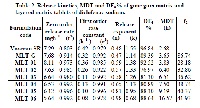n vitro Release kinetics and Bio availability of Layered Matrix tablets of Diclofenac Sodium
Keywords:
Diclofenac sodium, Matrix and layered matrix tablets, Controlled releasedAbstract
Controlled release tablets having near zero-order release of diclofenac sodium water soluble drug were prepared using guar gum (GG) in matrix core and Hydroxy Propyl Cellulose (HPC), Hydroxy Propyl Methyl Cellulose (HPMCK4M) and Sodium Carboxy Methyl Cellulose (Na CMC) as barrier layers. The optimum ratio of drug: guar gum was found to be 1:1, anionic GG in the matrix core and anionic Na CMC as barrier layers resulted in near zero order release of diclofenac sodium. Different dissolution models were applied to drug release data in order to evaluate release mechanisms and kinetics. The nature of drug release from matrix tablets and layered matrix tablets followed non-Fickian diffusion and super case II mechanism respectively. Mean dissolution time (MDT) for the formulations MT-GG and MLT-06 were found to be 3.65h and 16.57h, while Dissolution Efficiency (DE8%) decreases, indicating that the release of drug is slower from layered matrix tablets. On the basis of in vitro release data, MLT-06 was subjected to bioavailability studies. The in-vivo characterization of diclofenac sodium in human volunteers from formulation MLT-06 showed delayed Tmax unaltered bio availability indicating a slow and controlled release of the drug from layered matrix tablets.
References
Colombo P, Conte U, Gazzaniga A, Maggi
L, Sangalli M. E, Peppas N. A, La Manna
A, Drug release modulation by physical
restrictions of matrix swelling. Int. J.
Pharm. 1990;63:43-48.
Conte U, Maggi L, Colombo P, La Manna
A. Multi-layered hydrophilic matrices as
constant release devices. J. Cont. Rel.
;26:39-47.
Conte U, Colombo P, Maggi L, La Manna
A, Compressed barrier layers for constant
drug release in swell able matrix tablets.
STP Pharma Sci. 1994;4:107-113.
Yihong Qui, Koplette F. Design of
sustained release matrix system for a highly
water soluble compound. ABT-089. Int J
Pharm. 1997;157:46-52.
U Conte, L Maggi, ML Torre, P Giunchedi
and La Manna A. Press-coated tablets for
time-programmed release of drugs.
Biomaterials, 1993;14:1017-1023.
Robinson MHE, Wheatley T and Leach I.
Non steroidal anti inflammatory druginduced colonic stricture. Digest. Dis. Sci.
;40:315-319.
Gohel MC, Panchal MK. Novel use of
similarity factors f2 and Sd for the
development of diltiazem HCl modifiedrelease tablets using a 3(2) factorial
design. Drug Dev. Ind. Pharm.
;28:77-87.
Banakar UV. Pharmaceutical Dissolution
Testing, 1st ed. Marcel Decker Inc, New
York 1992;191-194.
El-Sayed Y, Suleiman MS, Najib NM,
Abdul Hameed M. A study on the relative
bioavailability of a sustained release
formulation of diclofenac sodium. Int. J.
Clin. Pharmacol. Ther. Toxicol.
;27:276-279.
Carstensen JT. Theoretical aspects of
polymer matrix systems. In: Muller B W,
(Ed.) Controlled Drug Delivery. Wissen
schftliche Verlagsgesell schaft, Stuttgart,
;135-7
Langenbucher F, Möller H. Correlation of
in vitro drug release with in vivo response
kinetics, Pharm. Ind. 1983;45:623-628.






